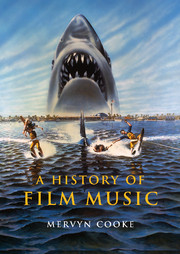Book contents
- Frontmatter
- Contents
- List of illustrations
- Preface and acknowledgements
- 1 The ‘silent’ cinema
- 2 Sound on track
- 3 Hollywood's Golden Age: narrative cinema and the classical film score
- 4 Stage and screen
- 5 The mainstream divides: post-war horizons in Hollywood
- 6 ‘Never let it be mediocre’: film music in the United Kingdom
- 7 Defectors to television
- 8 Film music in France
- 9 Global highlights
- 10 Popular music in the cinema
- 11 Classical music in the cinema
- 12 State of the art: film music since the New Hollywood
- Bibliography
- Index of film titles
- General index
10 - Popular music in the cinema
Published online by Cambridge University Press: 05 February 2015
- Frontmatter
- Contents
- List of illustrations
- Preface and acknowledgements
- 1 The ‘silent’ cinema
- 2 Sound on track
- 3 Hollywood's Golden Age: narrative cinema and the classical film score
- 4 Stage and screen
- 5 The mainstream divides: post-war horizons in Hollywood
- 6 ‘Never let it be mediocre’: film music in the United Kingdom
- 7 Defectors to television
- 8 Film music in France
- 9 Global highlights
- 10 Popular music in the cinema
- 11 Classical music in the cinema
- 12 State of the art: film music since the New Hollywood
- Bibliography
- Index of film titles
- General index
Summary
A large percentage of producers today are so unaware of their pictures they're looking for a musical gimmick to lure the public. Like the hit title tune, a harmonica surrounded by a choral group, the twanging sound of an electric zither, or the wail of a kazoo in an espresso café. Stuff like that. It only takes away from what's happening on the screen.
(bernard herrmann, quoted in hollywood reporter, 14 july 1964)i am particularly concerned with the need to break away from the old-fashioned cued-in type of music that we have been using for so long … unfortunately for we artists, we do not have the freedom that we would like to have, because we are catering to an audience … this audience is very different from the one to which we used to cater; it is young, vigorous and demanding … this is why i am asking you to approach this problem with a receptive and if possible enthusiastic mind.
(alfred hitchcock, cable to bernard herrmann, 4 november 1965; quoted in s. smith 1991, 268–9)The Torn Curtain fiasco, in which Herrmann's score for Hitchcock was rejected partly owing to pressure from the studio to include a hit song which the composer refused to provide (see Chapter 5), drew attention to a fundamental and seemingly irreconcilable tension in the mid-1960s between traditional methods of film scoring – increasingly viewed as outdated and inappropriate as films became more youth-oriented – and a more modern approach in which up-to-date popular idioms prevailed.
- Type
- Chapter
- Information
- A History of Film Music , pp. 396 - 421Publisher: Cambridge University PressPrint publication year: 2008



